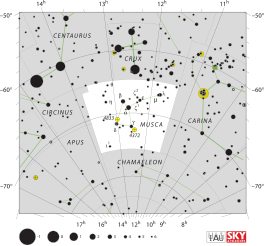|
Alpha Muscae
| Alpha Muscae
|

|
| Die ligging van Alpha Muscae (in die rooi sirkel).
|
| Sterrebeeld |
Vlieg
|
| Spektraaltipe |
B2 IV-V[1]
|
| Soort |
Hoofreeks-subreus
|
| Waarnemingsdata (Epog J2000)
|
| Regte klimming |
12h 37m 11.01789s[2]
|
| Deklinasie |
-69° 08′ 08.0332″[2]
|
| Skynmagnitude (m) |
2,69[3]
|
| Absolute magnitude (M) |
-2,2[4]
|
| B-V-kleurindeks |
-0,219[3]
|
| U-B-kleurindeks |
-0,854[3]
|
| Besonderhede
|
| Massa (M☉) |
8,8 ± 0,1[1]
|
| Radius (R☉) |
4,8[5]
|
| Ligsterkte (L☉) |
4 000[4]
|
| Ouderdom (jaar) |
18,3 ± 3,2 miljoen[1]
|
| Temperatuur (K) |
21 400[4]
|
| Rotasiespoed (km/s) |
114[6]
|
| Eienskappe
|
| Veranderlikheid |
Beta Cephei[7]
|
| Ander name
|
| CD-68 1104, CPD-68 1702, FK5 474, HD 109668, HIP 61585, HR 4798, SAO 251974[8]
|
|
|
Alpha Muscae (afgekort as α Mus) is ’n ster in die suidelike sterrebeeld Vlieg (Musca). Met ’n skynbare magnitude van 2,7[3] is dit die helderste ster in die sterrebeeld. Volgens parallaksmetings is die ster sowat 315 ligjare van die Son af.[2]
Eienskappe
Met ’n sterreklassifikasie van B2 IV-V[1] lyk dit of die ster besig is om weg van die hoofreeks te evolueer en ’n subreus te word terwyl die waterstof in sy kern aan die opraak is. Dit is groter as die Son: Sy massa is sowat nege keer soveel[1] en sy radius amper vyf keer soveel.[5] Sy ligsterkte is sowat 4 000 keer die Son s'n[4] en die effektiewe temperatuur van sy buitenste atmosfeer is 21 400 K,[4] wat dit die blouwit kleur van ’n B-tipe ster gee.[9]
Dit lyk of Alpha Muscae ’n Beta Cephei-veranderlike is. Telting en kollegas was baie seker dat dit ’n Beta Cephei is vanweë gereelde pulse in sy spektrum in ’n ondersoek wat in 2006 gepubliseer is,[7] hoewel Stankov en Handler (2005) dit as ’n swak of verwerpte kandidaat lys in hulle Catalog of Galactic β Cephei Stars.[6] Die ster roteer vinnig, teen sowat 114 km s-1,[6] en is omtrent 18 miljoen jaar oud.[1]
Alpha Muscae is ’n eiebeweginglid van die Laer-Centaurus-Crux-subgroep in die Scorpius-Centaurus-assosiasie (’n OB-assosiasie), die naaste groep swaar sterre aan die Son wat saam deur die ruimte beweeg.[4] Alpha Muscae beweeg teen ’n besonder vinnige snelheid van 10 km s-1 wat, hoewel dit hoog is, nie hoog genoeg is dat dit as ’n dwaalster gereken kan word nie.[1]
Verwysings
- ↑ 1,0 1,1 1,2 1,3 1,4 1,5 1,6 Tetzlaff, N.; Neuhäuser, R.; Hohle, M. M. (Januarie 2011), "A catalogue of young runaway Hipparcos stars within 3 kpc from the Sun", Monthly Notices of the Royal Astronomical Society 410 (1): 190–200, doi:10.1111/j.1365-2966.2010.17434.x, Bibcode: 2011MNRAS.410..190T
- ↑ 2,0 2,1 2,2 van Leeuwen, F. (November 2007), "Validation of the new Hipparcos reduction", Astronomy and Astrophysics 474 (2): 653–664, doi:10.1051/0004-6361:20078357, Bibcode: 2007A&A...474..653V
- ↑ 3,0 3,1 3,2 3,3 Gutierrez-Moreno, Adelina; Moreno, Hugo (Junie 1968), "A photometric investigation of the Scorpio-Centaurus association", Astrophysical Journal Supplement 15: 459, doi:10.1086/190168, Bibcode: 1968ApJS...15..459G
- ↑ 4,0 4,1 4,2 4,3 4,4 4,5 de Geus, E. J.; de Zeeuw, P. T.; Lub, J. (Junie 1989), "Physical parameters of stars in the Scorpio-Centaurus OB association", Astronomy and Astrophysics 216 (1-2): 44–61, Bibcode: 1989A&A...216...44D
- ↑ 5,0 5,1 Underhill, A. B. et al. (November 1979), "Effective temperatures, angular diameters, distances and linear radii for 160 O and B stars", Monthly Notices of the Royal Astronomical Society 189: 601–605, doi:10.1093/mnras/189.3.601, Bibcode: 1979MNRAS.189..601U
- ↑ 6,0 6,1 6,2 Stankov, Anamarija; Handler, Gerald (June 2005), "Catalog of Galactic β Cephei Stars", The Astrophysical Journal Supplement Series 158 (2): 193–216, doi:10.1086/429408, Bibcode: 2005ApJS..158..193S
- ↑ 7,0 7,1 Telting, J. H. et al. (Junie 2006), "A high-resolution spectroscopy survey of β Cephei pulsations in bright stars", Astronomy and Astrophysics 452 (3): 945–953, doi:10.1051/0004-6361:20054730, Bibcode: 2006A&A...452..945T
- ↑ "HD 109668 -- Variable Star of Beta Cep type", SIMBAD Astronomical Database, http://simbad.u-strasbg.fr/sim-id.pl?protocol=html&Ident=alpha+muscae, besoek op 2007-01-29
- ↑ "The Colour of Stars", Australia Telescope, Outreach and Education (Commonwealth Scientific and Industrial Research Organisation), December 21, 2004, archived from the original on 10 Maart 2012, https://www.webcitation.org/6630AbtJZ?url=http://outreach.atnf.csiro.au/education/senior/astrophysics/photometry_colour.html, besoek op 2012-01-16
Bronne
|
|